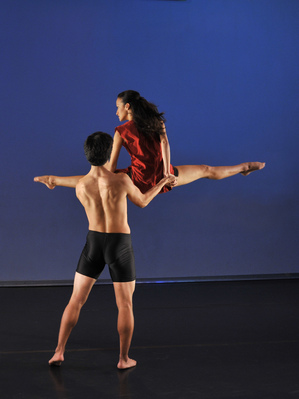"(Re)Visionary Dances" light on story but moves beautifully
Movement has a logic and impulse all its own.
Visionary-Dances-Morgan-Wallace-Betsy-Busald-thumb-300x414-26840.jpg)
From left, Morgan Wallace and Betsy Busald in choreographer Amy Chavasse's "Hunger for the Craving for the Longing for the Aching" as part of "(Re)Visionary Dances."
Peter Smith Photography
That’s the lesson, beautifully taught, by the dances that comprise the University Dance Company’s “(Re)Visionary Dances,” which opened a 4-performance run at the Power Center on Thursday evening.
Four dances — 3 by University of Michigan dance faculty and 1 by internationally renowned modern dance master Paul Taylor — make up the program, performed by students in the U-M dance department. The dancing is excellent, and so is the choreography — so much so that even where the stories the dance-makers purport to tell are a little foggy, it doesn’t much matter. You find yourself having a very good time, thank you, storyline be damned.
But in Taylor’s “Le Sacre du Printemps (The Rehearsal),” restaged for the U-M dancers by former Paul Taylor dancer Ruth Andrien, the narrative is clear — and coy. Taylor has substituted a delicious double-trouble detective story-cum-dance company tale for the pagan rites of the original “Sacre,” a landmark of 20th century ballet. His re-visioning of the work happily includes the 2-piano version of the Stravinsky score, though. One of the glories of the performance was the chance to hear Ilya Blinov and Christian Matjias play it live and in living color. Another was to see how the U-M dancers took to Taylor’s sly, 2-dimensional cops-and-robbers cutouts style here. It’s not easy being flat — or to be as sharp and precise as the movement demands in Taylor’s “Sacre” — but the cast, led by Sadie Yarrington as The Girl, was admirably good. Thayer Jonutz made a nicely square-jawed Private Eye and Derek Crescenti danced The Crook with just the right sly note. His Stooge, Samantha Goltz, had impeccable timing (especially for her last dastardly deed, which I won’t give away for those who have yet to see the show). His Mistress, Catherine Coury, and her doppelgänger the Rehearsal Mistress, Elizabeth Dugas, synched their mirror duet like pros.
The dances that comprise the first half of the show have much larger casts — the better to give all the department’s dancers a chance to be on stage in the annual Power Center concert. But happily, choreographers Amy Chavasse, Sandra Torijano and Jessica Fogel know how to move a crowd and have different ways of doing it. (Mary Cole, the dance department’s superb lighting designer, also knows how to light a crowd — or a soloist — and outdid herself this year in these dances and in re-creating Jennifer Tipton’s lighting for “Sacre.”)
Chavasse starts her piece with 2 dancers strolling down an aisle and up onto the Power Center stage, where they wiggle, dip and pose their way into the first lines of Woody Guthrie’s “This Land is Your Land.” The song, in varied incarnations and languages, forms the basis of “Hunger for the Longing for the Craving for the Aching (a biased history of seduction).” I can’t make much sense of the title, which is almost as long as the dance, nor do the charming, seductive poses and gestures of the dancers (which the dancers had a hand in choreographing) add up to the dissection of “the various ways seduction plays out in our culture,” as promised in the program notes. But in their bright ’50s-style costumes, the dancers do charm us with their sass and energy. And that, plus the music, is enough to please.

From top, Francesca Nieves and Richard Fernandez in choreographer Sandra Torijano's "La Luna Nueva" as part of "(Re)Visionary Dances."
Peter Smith Photography
The music collage that Torijano put together for her “La Luna Nueva” — Bach and Glass and Villa-Lobos — is also a plus. It’s a ravishing, rushing dance she has made (and which Rebecca Baygents Turk has costumed so beautifully), with mysteries that are not always solved for us. Who is Andrea Mathias, the girl in the white saucer tutu? What are the papers she scatters? What’s the role of the girl in the white tunic (Emily Wanserski)? How do they relate to the fiery couple in red (Francesca Nieves and Richard Fernandez)? The choreographer’s note — a poem by Nidia Marina Gonzalez — does not elucidate the dance, but again, watching the dancers was its own reward.
Though Fogel tackles a mightily abstract subject — modern physics — in her “Out of Thin Air: Lightness,” she makes it comprehensible and diaphanously beautiful in her choreography, bathed in a Milky Way glow by scenic designer Kasia Mrozewska and lighting designer Cole. Who knew a physics lesson could be lyrical? In words, and through music and movement, Fogel and her gauzy white-clad dancers make it so. The dance stops, rather than ends, but the atoms keep dancing in our heads for a minute after.
Susan Isaacs Nisbett is a free-lance writer who covers classical music and dance for AnnArbor.com.

